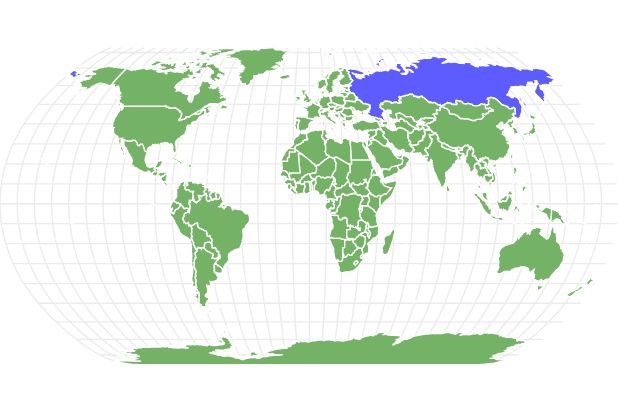Yakutian Laika
Canis lupus
The Yakute people were likely the first to use dogs to pull sleds, so the Yakutian Laika was probably among the first sled dogs.
Advertisement
Yakutian Laika Scientific Classification
- Kingdom
- Animalia
- Phylum
- Chordata
- Class
- Mammalia
- Order
- Carnivora
- Family
- Canidae
- Genus
- Canis
- Scientific Name
- Canis lupus
Read our Complete Guide to Classification of Animals.
Yakutian Laika Conservation Status
Yakutian Laika Facts
- Fun Fact
- The Yakute people were likely the first to use dogs to pull sleds, so the Yakutian Laika was probably among the first sled dogs.
- Temperament
- Friendly, active, and intelligent
- Diet
- Omnivore
Yakutian Laika as a Pet:
- General Health
- Energy Level
- Shedability
- Trainability
- Intelligence
- Tendency to Chew
- Size
- Family and kid friendliness
- Yappiness / Barking
- Moderate
- Separation Anxiety
- Low
- Preferred Temperature
- Cold climate
- Exercise Needs
- High
- Friendly With Other Dogs
- Moderate
- Pure bred cost to own
- $1,200 to $1,400
- Dog group
- Working
- Male weight
- 40-55 lbs
- Female weight
- 40-55 lbs
This post may contain affiliate links to our partners like Chewy, Amazon, and others. Purchasing through these helps us further the A-Z Animals mission to educate about the world's species.
View all of the Yakutian Laika images!
The Yakute people were likely the first to use dogs to pull sleds, so the Yakutian Laika was probably among the first sled dogs.
While Yakutian Laikas only recently become more well-known in other parts of the world, they are an ancient breed. As you may be able to guess based on their name, they first originated in the Yakutia region of Russian Siberia. The breed was used by the Yakute people in the region for herding reindeer, hunting, and pulling sleds across the snowy and icy terrain. In fact, the Yakute people were the first group that is known to have used sled dogs. Sadly, the number of Yakutian Laikas started to decrease with technological advancements and other methods of transportation. However, the breed was saved in 1998 by a group of individuals who worked hard to keep it going.
See all of our expert product reviews.
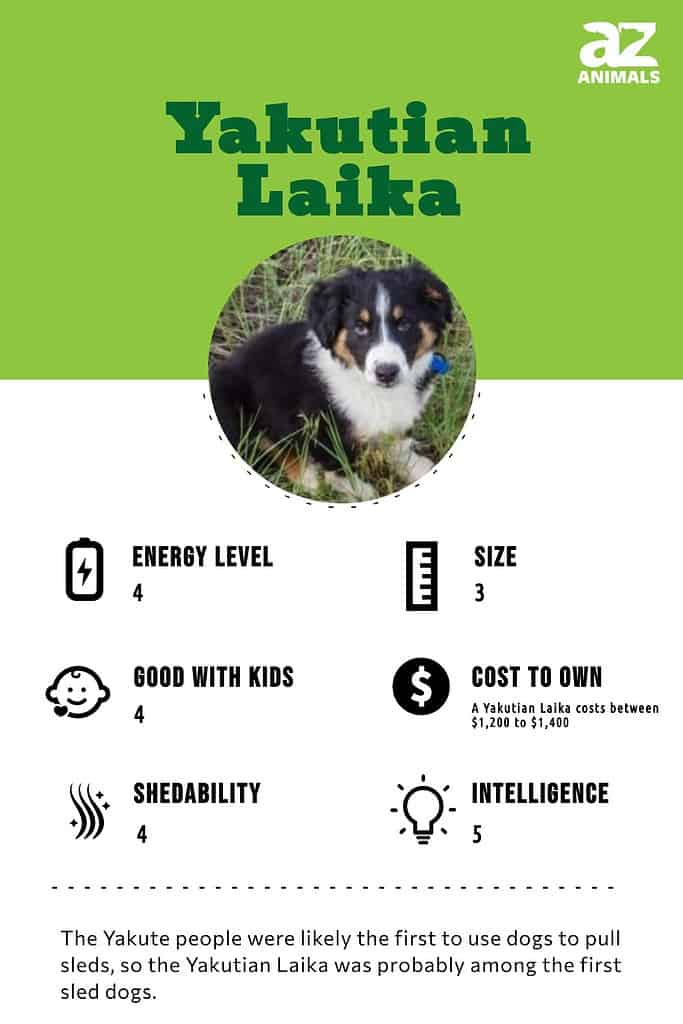
Personality of the Yakutian Laika
Yakutian Laikas are very smart, eager to please, and pretty easy to train. Overall, they do well with children and can make a wonderful family pet. However, since this breed has a high prey drive, they are not ideal for homes with cats or other smaller animals.
This dog was purposely bred to be obedient to humans rather than obedient towards them. Even though the Yakutian Laika has excellent hearing and a sense of smell, which are great characteristics in a watch dog, this breed does not do well in that role. They are just too friendly. But they get along great with other pet dogs, as their role pulling sleds required they work together well.
Owning a Yakutian Laika: 3 Pros and Cons
| Pros! | Cons! |
|---|---|
| Easy to train: Overall, a Yakutian Laika is easy to train. They are smart and look to please their owner. | High prey drive: Yakutian Laikas have a very high prey drive and are probably not a good fit for homes with cats or small dogs. |
| Friendly: With proper socialization from an early age, these dogs can be very friendly and social with people. | Not suited for hot climates: These dogs have a heavy coat and can overheat easily in hot climates. |
| Healthy: Yakutian Laikas are healthy and do not typically suffer from genetic diseases. | High maintenance: Ideally, Yakutian Laikas should be brushed every day to keep their shedding under control during their shedding seasons. |
Size and Weight
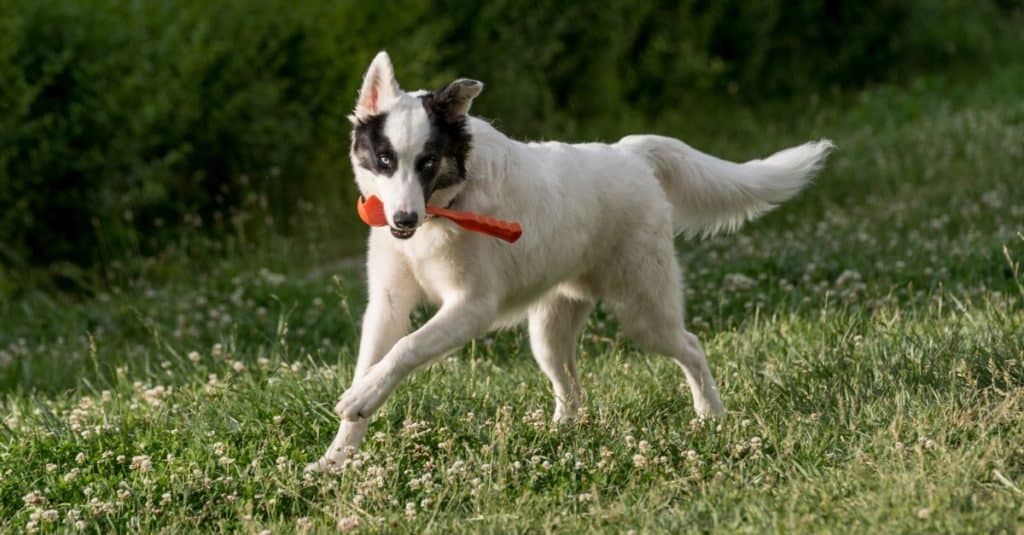
©Julian Popov/Shutterstock.com
These dogs are a large breed dog. Males and females are typically around the same size, with a height between 21 and 33 inches and a weight between 40 and 55 pounds.
| Height (Male) | 21 inches to 33 inches |
| Height (Female) | 21 inches to 33 inches |
| Weight (Male) | 40 pounds to 55 pounds |
| Weight (Female) | 40 pounds to 55 pounds |
Origins
The canine recognizable by its pale eyes and mostly white, occasionally oddly colored coat was first used by the Yakute. Considered to be the very first people on the planet to use dogs for transport, they are also credited with having used the Yakutian Laikas for that very purpose.
Health and Entertainment for your Yakutian Laika
See all of our expert product reviews.
As a matter of fact archeological evidence has been found dating back to 8,000 years showing their use with harnesses.
When not pulling sleds, Laika helped with keeping reindeer in line, ensuring they remained close together, moving in the right direction dictated by the herder.
These highly intelligent, athletic canines were also used to hunt waterfowl as well as foxes which were treasured for their pelts and even helped to lug wood for fuel.
For about half a century (between the 1940s and 1990s), populations of the species plummeted owing to the introduction of machinery to the Arctic as well as the presence of disease.
Thankfully their fortunes soon improved thanks the to efforts of canine enthusiasts. In 1998 the breed was recognized in Russia, and its popularity subsequently spread to the rest of the world.
Common Health Issues

Yakutian Laikas generally enjoy good health but may however be susceptible to bloat
©cynoclub/Shutterstock.com
Overall, these dogs are a healthy breed. However, as with all dog breeds, there are a few health concerns to be on the lookout for.
One potential health issue a Yakutian Laika may face is bloat. Bloat (gastric dilation-volvulus-GDV) is a condition that can impact larger dog breeds. The stomach twists and traps air, causing a potentially life-threatening situation. While the exact cause of GDV is not known, there is a link between eating a large meal followed by exercise, so take care to feed smaller meals and limit your dog’s activity after mealtimes.
They may also develop hip or elbow dysplasia. These are inherited conditions where the hip or elbow joints don’t develop correctly and rub against each other. They can cause the dog a lot of pain and may require surgery to remedy.
Yakutia Laikas may also be prone to more eye troubles. It is important to schedule regular checkups with a veterinarian to confirm there are no issues that need to be addressed.
In summary, some common health issues they may face include:
- Bloat
- Hip dysplasia
- Elbow dysplasia
- Eye problems
Temperament and Behavior
These dogs have a very friendly personality, especially with the people they trust in their family. Overall, their traits make them good pets for homes with children, particularly those they are raised with. They can be very affectionate and playful. However, they may not be as tolerant of more rambunctious children or those who may try to grab or pull the dog.
While these dogs are often more reserved around strangers, they are unlikely to exhibit any aggressive behaviors unless they sense a threat to their family members.
How to Take Care of a Yakutian Laika
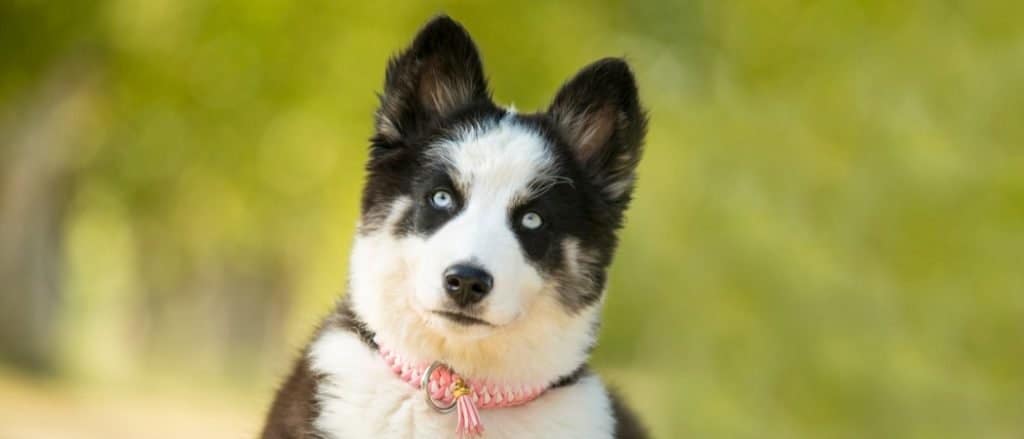
Yakutian Laikas are best fed wet food since dry food can cause bloat
©Melounix/Shutterstock.com
As you plan to care for your new dog, keep the breed’s temperament, health concerns, nutritional needs, activity requirements, and grooming needs in mind.
The Best Dog Food for Yakutian Laikas
When choosing food for your dog, look for a high-quality option. You may choose to purchase prepared food or make your own food at home. Whichever option you choose, consult with your dog’s veterinarian to ensure they’re getting the nutrients they need to stay healthy. The right amount of food for your Yakutian Laika can vary based on her weight, age, activity level, health needs, and other factors, so your veterinarian can be a good resource in this respect as well. To prevent potentially fatal bloat, make sure your Yakutian Laika doesn’t get too much activity immediately before or after eating.
If you are bringing home a puppy, it is important to realize that puppies will need to eat smaller meals more frequently throughout the day. They have smaller stomachs and can’t handle as much food as a full-grown dog can eat at one time.
Since dry food can swell in contact with water and contribute to bloat, Yakutian Laika owners may want to consider wet dog food instead.
That’s why A-Z Animals thinks this is the best dog food for your Yakutian Laika: Blue Buffalo True Solutions Jolly Joints Natural Mobility Support Adult Wet Dog Food.
This joint support formula is packed with vital chondroitin sulfate and glucosamine, clinically proven to build and maintain strong hips, knees, and elbows, with EPA from fish oil to enhance mobility. Instead of nutritionally lacking poultry by-product, corn, soy, and artificial preservatives, this mobility support wet dog food adds taurine, amino acids, and a host of vitamins to your Yakutian Laika’s diet for nose-to-tail wellness.
Check out Blue Buffalo True Solutions Jolly Joints Wet Dog Food on Chewy or Amazon.
- Glucosamine and chondroitin support healthy hips and joints, EPA from fish oil encourages healthy mobility and minerals promote strong bones.
- Crafted with natural ingredients and enhanced with vitamins, minerals and other nutrients.
- Made with real chicken as the very first ingredient, followed by fruits and veggies to naturally support mobility.
- Wheat-free recipe made without chicken (or poultry) by-product meals or other common food allergens like corn, wheat or soy.
- 100% free from artificial flavors and preservatives.
Maintenance and Grooming
These dogs are not a hypoallergenic breed as they shed. Most times throughout the year, the dog will require weekly brushing to keep his coat looking its best. However, they do experience seasonal shedding, when they will require daily brushing to keep the shedding under control and prevent the hair from tangling or getting matted.
You should also brush your teeth regularly to prevent plaque and tartar buildup or dental disease. Be sure to also keep your Yakutian Laika’s ears clean and free of wax or debris.
Training
These dogs are a pretty easy breed to train. They are very intelligent, and, as long as they trust their owner, will respond well to training. However, they are not very responsive to corrective training methods but do best with more positive training strategies. They can also be motivated by treats during the training process.
Exercise
These dogs have a medium-high energy level. Making sure this breed gets sufficient exercise is essential. They were used as sled dogs in the past, and as such are used to doing a lot of daily work. They may enjoy taking a long walk with you, running alongside you as you ride a bike, playing catch in the yard, or pulling a sled.
Puppies
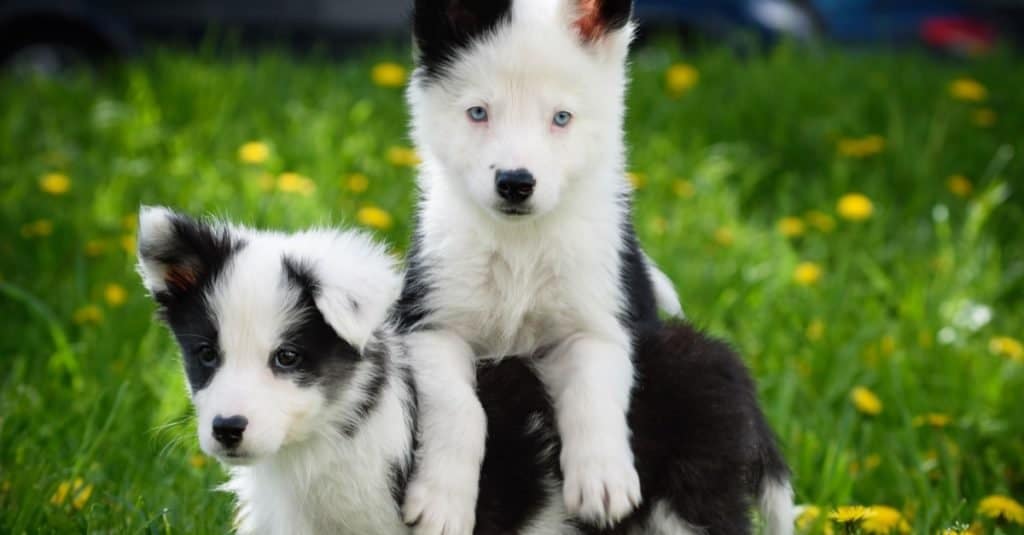
©Elisabeth Abramova/Shutterstock.com
If you’re looking to adopt a puppy, you may find it challenging to do so depending on your location. This is a rarer breed that has not even gained recognition by many North American kennel clubs.
If you do find a puppy to bring home, make sure your home is ready for the pup first. Puppy-proof the space where the dog will spend most of his time. Also, be prepared to give puppies and adults the training and exercise they’ll need to thrive.
Children
These dogs generally are good family dogs. They do well with children and can be very affectionate with them. This breed can also be highly protective of the children and other members of his family. They typically do best when they are raised with children in a home. However, while a Yakutian Laika can be very gentle with children, they are also not very tolerant of children who are not respectful towards them.
Dogs similar to Yakutian Laika
Siberian Huskies, Alaskan Malamutes, and Samoyeds are three breeds that are similar to these dogs.
- Siberian Husky: Siberian Huskies and Yakutian Laikas have both been used as sled dogs. Both breeds can be quite friendly and are known to shed a good amount. A Yakutian Laika is typically easier to train than a Siberian Husky.
- Alaskan Malamute: Alaskan Malamutes are another breed that was used to pull sleds. Alaskan Malamutes and Yakutian Laikas are both affectionate and very intelligent. Alaskan Malamutes are a larger breed though and weigh between 75 and 100 pounds compared to the 40 to 55 pounds that a Yakutian Laika typically weighs.
- Samoyed: Samoyeds are yet another breed that was used to pull sleds over the icy terrain. They also have long hair and shed a lot, like a Yakutian Laika. A Samoyed’s coat is white, cream, or beige, while a Yakutian Laika may also have some black, brown, or gray fur in addition to the white in their coat.
Famous Yakutian Laikas
Want to follow some Yakutian Laika pups on Instagram to get your daily dose of cuteness from this unique breed? Check out some of these pages:
Popular Names for Yakutian Laika
Give one of these names a try for your pup:
- Aspen
- Kodiak
- Hunter
- Maverick
- Comet
- Aurora
- Nova
- Sierra
- Sky
- Tundra
Yakutian Laika FAQs (Frequently Asked Questions)
How much does a Yakutian Laika cost to own?
The price to purchase a Yakutian Laika can vary based on the breeder you choose, your location, and other factors. Keep in mind that this is not a very popular breed, so finding a breeder may be a challenge. Generally, the price to purchase a Yakutian Laika will be between $1,200 and $1,400. It is also possible to find a Yakutian Laika through a rescue organization. The price to adopt may vary, but will likely be a few hundred dollars.
Don’t forget that the average lifespan of a Yakutian Laika is 10 to 12 years. In addition to the price you’ll pay to adopt the dog, you’ll also need to be prepared to take care of him or her for the full 10-to-12-year lifespan. Budget at least $1,000 to $1,500 for the first year and between $500 and $1,000 for each following year.
Is a Yakutian Laika good with kids?
Yes, Yakutian Laikas can be very good with kids. They are affectionate and protective. They will do best when they are raised with the children in a family. However, this breed is not as tolerant of children who are not being respectful and are being too rambunctious or trying to pull or grab the dog.
How long does a Yakutian Laika live?
The average lifespan of a Yakutian Laika is 10 to 12 years.
Are Yakutian Laikas easy to train?
Yes, Yakutian Laikas are easy to train. They are a very intelligent breed who has been trained for tasks such as pulling sleds, herding reindeer, and hunting.
Does a Yakutian Laika shed?
Yes, Yakutian Laikas shed and will require weekly brushing. During their shedding season, they should be brushed daily as they will be shedding much more heavily. This is not a hypoallergenic dog breed.
Are Yakutian Laikas smart?
Yakutian Laikas are a very intelligent breed. They are capable of being trained to accomplish challenging tasks such as herding animals or pulling a heavy sled.
Thank you for reading! Have some feedback for us? Contact the AZ Animals editorial team.
Sources
- American Kennel Club, Available here: https://www.akc.org/dog-breeds/yakutian-laika/
- Wikipedia, Available here: https://en.wikipedia.org/wiki/Yakutian_Laika
- The Spruce Pets, Available here: https://www.thesprucepets.com/yakutian-laika-dog-breed-profile-512075
- Wag Walking, Available here: https://wagwalking.com/breed/yakutian-laika

